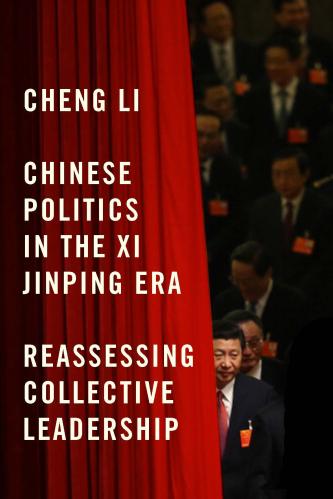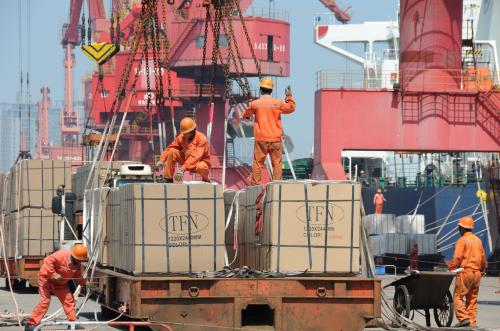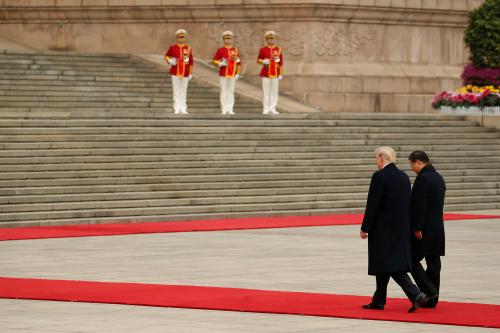Presidents Trump and Xi met on June 29, on the margins of the G-20 summit in Osaka, Japan, continuing the practice of holding leader-level meetings at multilateral events whenever both the U.S. and Chinese leaders are present. Authoritative Chinese readouts of the meeting from official media have been tonally positive but vague about the outcomes; the same holds for President Trump’s public characterizations.
This generally positive but non-specific characterization likely reflects that both leaders covered a range of issues in a short period of time, and did so without the benefit of detailed preparatory negotiations to define outcomes that both leaders could affirm. Even so, a few early takeaways from the meeting are visible.
For Beijing, key outcomes include:
- No new tariffs. President Trump earlier had threatened to impose tariffs on the roughly $300 billion of Chinese imports that currently fall outside of existing taxes on imports. This list includes popular consumer items such as smart phones, tablets, laptops, and cameras. Trump pledged to withhold tariff escalation to enable an opportunity for negotiators to reach a trade deal.

- Reduced pressure on Huawei. President Trump indicated that American companies could sell to telecom giant Huawei “where there is no great national emergency problem with it.” Irrespective of how many products the Trump administration exempts for sale to Huawei, the broader impact is that Trump effectively gutted the U.S. global campaign to compel other countries to sever ties with the company. If President Trump sees Huawei as an object of leverage in negotiations, but not a national security threat, it is likely that many other countries similarly will discount the national security risk posed by Huawei.
- Resumption of open-ended trade negotiations. Since one of China’s goals is to play for time, many in Beijing likely will be relieved that Trump chose not to set a deadline for negotiations. Beijing sees value in prolonging negotiations both because it judges that Trump will grow more desirous of a deal the closer he gets to the U.S. election, and also because it calculates Trump will have more incentive to quash policy initiatives that could cloud the atmosphere for negotiations (e.g., new actions on Taiwan, additional technology export controls, sanctions on officials handling Xinjiang affairs, etc.) when talks are ongoing.
- Better treatment for Chinese students. Intensifying American law enforcement and media scrutiny of Chinese students’ activities in the United States has become a raw topic in China, where many families have aspired to send their children to the United States for academic training, but have been growing more reluctant due to concerns about racial profiling.
- Strategic direction. Amidst a growing cacophony of calls in the United States for treating China as a rival, Trump departed from his top advisors to predict that “we’re going to be strategic partners.”
For Washington, key outcomes include:
- Resumption of agricultural purchases. Over the past year, China has responded to American tariffs in part by diversifying its purchases of agricultural products away from the United States. This has impelled the Trump administration to allocate $28 billion in “trade aid” to quell dissatisfaction from victims of tensions with China. Following their meeting in Osaka, President Trump declared that Xi had agreed to resume purchases of American agricultural products on an unspecified range of goods and at an undefined amount. Chinese media reports noted that Trump requested a resumption of purchases and did not dispute Trump’s characterization of the outcome.
- Avoidance of failure. In resuming negotiations, Trump and Xi showed they both remain committed to pursuing efforts toward a trade deal. Anything short of this would have dented President Trump’s preferred image as a “dealmaker.”
- Continuation of existing tariffs. The United States currently levies 25% tariffs on roughly $250 billion of Chinese imports, including items ranging from televisions to food and clothing. Members of the Trump administration believe that the longer these tariffs remain in place, the more pressure firms will feel to move supply chains outside of China in order to avoid having their products taxed at a 25% rate upon entering the United States. And, according to this logic, the more that companies move out of China, the more that China’s strength to compete against the United States will be sapped.
Looking ahead, key signposts to watch will include:
- Size and composition of Chinese agricultural purchases. The purchase numbers will likely bear on American public perceptions of how committed China is to narrowing differences in the trade dispute.
- Details on relaxation of restrictions on sales to Huawei. If the United States maintains tight controls on sales of technology products to Huawei despite President Trump’s vague assurances that Huawei is an issue that can be managed and negotiated, it could erode confidence in Beijing that President Trump’s positive statements with President Xi will translate into durable policy adjustments toward a mutually acceptable trade deal.
Public revelations about Huawei’s malfeasance. If new media stories emerge, citing U.S. government sources, highlighting risks arising from Huawei’s involvement in telecommunications systems, it could shrink space for President Trump to relax restrictions on sales to Huawei, including by inviting greater congressional activism in limiting Trump’s freedom for maneuver.
Resumption of trade negotiations. Observers will watch how quickly U.S. and Chinese negotiating teams resume efforts, and whether both sides exhibit urgency toward concluding an agreement.
Exogenous factors. Even if both leaders have political will to conclude a trade deal, they may confront obstacles in other areas of the relationship—or other areas of the world—that complicate their ability to do so. For example, tensions over technology and Taiwan are likely to intensify, and divergences over Iran could complicate the overall relationship. It will be worth watching how well both sides are able to compartmentalize challenges within the broader relationship.
This list is illustrative, not exhaustive. It is intended to highlight the dynamic nature of the U.S.-China relationship. With political will, pragmatism, and determination, a trade deal remains within reach for both leaders. Such an outcome is far from a foregone conclusion, though.
The Brookings Institution is committed to quality, independence, and impact.
We are supported by a diverse array of funders. In line with our values and policies, each Brookings publication represents the sole views of its author(s).










Commentary
What the US and China each got out of the Trump-Xi meeting in Japan
July 1, 2019